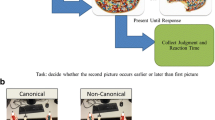Conclusion
To summarise, the phenomenon of temporal displacement came to light through astronomy and it formed one of the first problematic issues of experimental psychology. It represented, in fact, a typical case of dissimilarity between the characteristics of physical reality and those of erceptive reality.
Nearly a century ago Benussi had, with deep philosophical awareness, grasped the complexity of the phenomenon. Such awareness was derived from his understanding of the sophisticatedGegenstandstheorie that evolved from the Graz theory. Moreover, with great experimental skill, he succeded in formulating and describing the controlled situations in which such a discrepancy manifested itself.
Thereore, current research, which is carried out within the difficult discipline of the ‘psychology of time,’ cannot ignore his pioneering contribution.
Similar content being viewed by others
References
L. Albertazzi, “Enzo Bonaventura: strutture temporali e ontologia,” in L. Albertazzi, G. Cimino and S. Gori-Savellini, eds.,De Sarlo e il laboratorio fiorentino di psicologia, Giuseppe Laterza ed., Bari.
L. Albertazzi, “Eventi sonori,” in L. Albertazzi, ed.,La percezione musicale, Guerini, Milan.
Die experimentelle Analyse des Bewusstseins bei V. Benussi, Rodopi, Amsterdam.
V. Benussi,Psychologie der Zeitauffassung, Winter, Heidelberg.
V. Benussi, Schede riassuntive delle opere di Benussi, manuscript, Fondo Benussi carteggio, 1926.
R.A. Block,Cognitive models of psychological time, Lawrence Erlbaum Associates, Hillsdale.
E. Bonaventura,Il problema psicologico del tempo, Società anonima Istituto editoriale scientifico, Milan.
P. Bozzi, “Higher-order objects,” in L. Albertazzi, M. Libardi and R. Poli, eds.,The School of Franz Brentano, Kluwer, Dordrecht.
P. Bozzi,Fenomenologia sperimentale. Il Mulino, Bologna.
G. Buccola,La legge del tempo nei fenomeni di pensiero, Fratelli Dumolard, Milan.
S. Cattaruzza, “The Philosophy of Psychology by Benussi,” in W. Baumgartner and others,Phenomenology and Cognitive Science, Röll, Dettelbach.
S. Exner, “Experimentelle Untersuchung der einfachsten psychischen Processe,”Plugers Archiv für die gesamte Physiologie 11, 403–32.
P. Fraisse,Psychologie du temps, Presses Universitaires de France, Paris.
F. Guardione,Scritti di Gabriele Buccola, Arti Grafiche Castiglia, Palermo.
L. Guinzburg, “È possibile l’apprendimento di sensazioni eterogenee come perfettamente simultanee?,”Archivio Italiano di Psicologia 4, 103–14.
P. Ladefoget and D.E. Broadbent, “Perception of sequence in auditory events,”Quarterly Journal of Experimental Psychology 12, 162–70.
B. Libet, “Consciousness: Conscious Subjective Experience,”Encyclopaedia of Neuroscience, Birkhäuser, George Adelman, vol. 1.
A. Meinong, “Ueber Gegenstände höherer Ordnung und deren Verhaltniss zur inneren Wahrenehmung,”Zeitschrift für Psychologie und Physiologie der Sinnesorgane 21, 182–272.
E. Meumann, “Beiträge zur Psychologie des Zeitsinns,”Philos. Stud. 8, 431–519.
A. Michotte, “Nouvelles recherches sur le simultaneité apparente d’impressions disparates périodiques,”Ann. Inst. Sup. Philos.
R. Pauli, “Über die Beurteilung der Zeitofdnung von optischen Reizen,”Arch. Geg. Psychol. 21, 132–218.
W. Reichardt, “Autocorrelation, a Principle for the Evaluation of Sensory Information by Central Nervous System,” in W.A. Rosenblith, ed.,Sensory Communication, New York, Wiley.
E. Rubin,Experimenta psychologica, Copenhagen, Munksgaard.
E.C. Sanford, “Personal Equation,”The American Journal of Psychology 2, 38.
L.W. Stern, “Psychische Prasenzzeit,”Zeitschrift für Psychologie und Physiologie der Sinnesorgane, 13, 325–49.
J.M. Stroud, “The fine structure of psychological time,” in H. Quaster,Information Theory in Psychology, Free Press, Glencoe.
G.B. Vicario,Tempo psicologico ed eventi, Giunti Barbera, Florence.
G.B. Vicario, “Il tempo in psicologia,”Le Scienze, 43–51.
G.B. Vicario, “Discutendo di coscienza,”Giornale Italiano di Psicologia 24, 67–81.
G.B. Vicario and E. Zambianchi,La percezione degli eventi, Guerini, Milan.
W. Wundt,Grundzüge der physiologischen Psychologie, Engelmann, Leipzig.
Author information
Authors and Affiliations
Rights and permissions
About this article
Cite this article
Sinico, M. Benussi and the history of temporal displacement. Axiomathes 10, 75–93 (1999). https://doi.org/10.1007/BF02681817
Issue Date:
DOI: https://doi.org/10.1007/BF02681817




